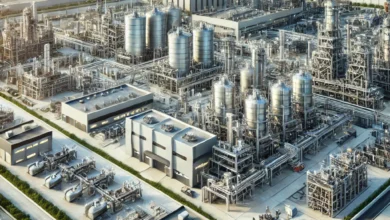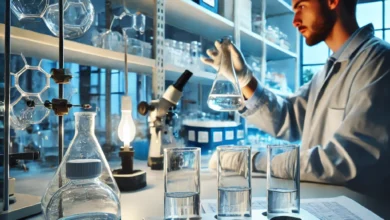Transforming the Future with Fiberglass Pultrusion: A Deep Dive into Efficiency and Innovation

Pultrusion, a highly effective process for producing continuous lengths of reinforced composite materials, has been quietly transforming industries across the world. Among its remarkable advances, the fiberglass pultrusion machine stands out as an innovative technology that has revolutionized the production of lightweight yet incredibly strong structural components. This blog explores the benefits of fiberglass pultrusion, emphasizing the importance of this technology for industries seeking durable, sustainable, and versatile solutions.
Fiberglass pultrusion is a unique method of shaping composite materials, ideal for applications that demand high strength-to-weight ratios. Imagine building bridges, utility poles, or even aircraft components without the overwhelming weight of traditional materials like steel or aluminum, but with the same—if not superior—performance. Pultrusion provides the solution, allowing industries to replace cumbersome, expensive materials with reinforced composites that offer an outstanding range of properties.
The true value of the fiberglass pultrusion machine lies in its ability to create consistently strong and reliable products with minimal waste. By pulling continuous strands of glass fibers through a resin bath and then passing them through a heated die, manufacturers can achieve an uninterrupted production process that guarantees consistent quality. This approach helps maintain low production costs while yielding products that are resistant to corrosion, heat, and electrical conductivity—a trio of benefits that makes pultruded fiberglass highly suitable for a variety of demanding environments.
The fiberglass pultrusion machine provides significant advantages over traditional materials, especially when it comes to infrastructure projects. Its production process ensures that pultruded components maintain a consistent quality and uniformity that is crucial for projects where structural reliability is non-negotiable. The resistance to moisture and chemicals also makes fiberglass composites highly suitable for outdoor and harsh environments. For industries involved in construction, marine, and transportation, the material’s properties are a clear advantage.
Advantages of Fiberglass Pultrusion Machines
- Durability and Strength Fiberglass pultrusion machines produce composite profiles with a unique combination of strength and durability. Unlike traditional materials such as wood, steel, or aluminum, fiberglass is resistant to corrosion and rot. This makes it especially useful in environments that experience harsh weather conditions or prolonged exposure to moisture. Pultruded fiberglass structures are built to last, resulting in lower maintenance costs and extended service life.
- Cost Efficiency Due to the nature of its continuous production process, pultrusion results in significantly lower labor costs compared to other manufacturing techniques. The fiberglass pultrusion machine allows for high-speed, continuous production of complex shapes, which makes it extremely cost-effective for both short and long production runs. Moreover, reduced raw material waste during production leads to more economical use of resources, which further reduces costs.
- Lightweight Properties One of the key benefits of fiberglass is its lightweight nature. Pultruded fiberglass profiles have a high strength-to-weight ratio, which makes them perfect for applications where weight reduction is crucial. The aerospace and automotive industries benefit immensely from lightweight components because they contribute to increased fuel efficiency, reduced emissions, and better overall performance. From industrial platforms to portable ladders, fiberglass pultrusion products offer unmatched advantages in portability and ease of installation.
- Environmental Benefits Sustainability is another significant benefit of the fiberglass pultrusion process. Since pultrusion generates very little waste, it is one of the most eco-friendly methods for producing composite materials. Fiberglass pultrusion machines produce no VOC (volatile organic compounds) emissions, and fiberglass itself is a recyclable material. The longevity of the final product also means fewer resources are used over time to repair or replace it, leading to a smaller carbon footprint.
- Resistance to Corrosion and Weathering The fiberglass pultrusion process yields products that are highly resistant to environmental factors such as UV radiation, chemicals, and extreme weather. As a result, pultruded components are well-suited for outdoor applications that face constant exposure to the elements. Fiberglass utility poles, for instance, are resistant to rot, insects, and rust—features that make them a practical replacement for traditional wood or metal poles.
- Customizability A significant advantage of fiberglass pultrusion is the ability to customize the products to meet specific application requirements. The shape of the die can be tailored to create a variety of profiles, including solid rods, tubes, I-beams, channels, and more. This versatility has opened doors for creative and diverse uses of fiberglass composites, providing options that align precisely with the needs of different industries.
- Non-Conductive Nature In environments where electricity presents a hazard, pultruded fiberglass materials have the added advantage of being non-conductive. This property makes them ideal for the construction of electrical enclosures, ladders, and handrails in workplaces where electrical safety is a top priority. The fiberglass pultrusion machine provides consistent, high-quality products that do not conduct electricity, adding an extra layer of safety to industrial work environments.
- Low Thermal Conductivity Another unique property of fiberglass pultrusion is its low thermal conductivity. The pultruded profiles maintain temperature resistance, which makes them suitable for use in applications where insulation is required. This feature is particularly valuable for offshore installations, cooling towers, and other applications where thermal stability is essential.
Visit https://incomepultrusion.com/pultrusion-machine/ to explore fiberglass pultrusion machines designed for efficient, durable composite production.
Applications of Fiberglass Pultrusion
- Construction and Infrastructure In construction, fiberglass pultruded profiles are used to create structures such as pedestrian bridges, handrails, ladders, walkways, and decking. Their resistance to corrosion makes them an ideal replacement for metal in environments such as water treatment facilities, cooling towers, and chemical processing plants. Pultruded fiberglass materials are highly resistant to degradation from chemicals and environmental elements, ensuring a long lifespan with minimal maintenance.
- Electrical and Telecommunications Fiberglass is a popular choice for the electrical and telecommunications industry because of its non-conductive properties. Pultruded components such as cable trays, enclosures, and poles are used extensively for electrical applications. Since these components do not conduct electricity, they provide an added measure of safety in environments where electrical exposure is a risk.
- Marine Industry In marine environments, corrosion and constant exposure to moisture pose significant challenges to traditional building materials like steel or wood. Fiberglass pultrusion is an excellent solution, providing robust, durable profiles that are highly resistant to the rigors of marine environments. Whether used for docks, piers, or components in boats, pultruded fiberglass is a highly effective solution for resisting the effects of saltwater and sun exposure.
- Automotive and Aerospace Lightweight, high-strength materials are a necessity in the automotive and aerospace industries, where reducing weight can lead to enhanced fuel efficiency and better performance. The fiberglass pultrusion machine enables the production of components that are not only lightweight but also extremely strong and durable, contributing to improved efficiency and reduced emissions in these sectors.
- Oil and Gas Fiberglass pultrusion is particularly useful in the oil and gas industry, where there is constant exposure to corrosive chemicals and extreme environmental conditions. Pultruded grating and structural components are used on offshore oil platforms and refineries where durability, corrosion resistance, and fire resistance are essential for safe and reliable operations.
How Fiberglass Pultrusion Compares to Traditional Manufacturing
The advantages of the fiberglass pultrusion machine over traditional manufacturing methods are numerous. Pultrusion requires less manual labor, resulting in consistent product quality and reduced production times. It also eliminates the need for post-processing, such as cutting or finishing, since the profiles are manufactured to the desired length during the pultrusion process.
Moreover, traditional metal components often suffer from corrosion, leading to frequent repairs and high maintenance costs. In contrast, fiberglass pultruded parts are inherently corrosion-resistant, providing a long-lasting alternative that requires less maintenance. This means that while the initial investment in pultruded fiberglass materials may be higher than that for metal, the overall lifecycle cost is considerably lower due to the reduced need for upkeep.
Challenges in the Pultrusion Industry
Despite its advantages, the pultrusion industry faces a few challenges. Fiberglass pultrusion is less flexible when it comes to intricate shapes and designs compared to other composite manufacturing methods, such as molding or 3D printing. While the pultrusion process is highly efficient for creating linear profiles, the limited design flexibility can be a constraint for some applications.
Another challenge is the upfront cost of setting up a fiberglass pultrusion machine. The equipment and dies used in the process can be expensive, which may pose a barrier for smaller manufacturers or companies with limited budgets. However, the long-term savings from reduced waste, lower labor costs, and minimized maintenance make pultrusion an economically viable solution for many industries.
Future Trends in Fiberglass Pultrusion
The future of fiberglass pultrusion looks promising, with ongoing advancements in materials science and automation technologies. Innovations such as robotic integration in pultrusion lines and the development of advanced resin formulations are set to make pultrusion even more efficient and capable of meeting the evolving needs of the industry. Automated quality control systems are also being integrated into pultrusion machines, which will help ensure that each product meets strict quality standards without manual inspection.
There is also an increasing emphasis on sustainable manufacturing practices, and pultrusion is well-positioned to meet this demand. As industries shift towards greener alternatives, the low environmental impact of the pultrusion process and the recyclability of fiberglass make it a key player in the sustainable production of composite materials.
Conclusion
The fiberglass pultrusion machine is an essential part of modern manufacturing, offering a range of benefits that make it ideal for industries looking for lightweight, durable, and corrosion-resistant materials. Its ability to produce consistent, high-quality products with minimal waste positions fiberglass pultrusion as a leader in composite manufacturing.
The growing demand for sustainable solutions and lightweight, high-strength materials across multiple industries suggests that the adoption of fiberglass pultrusion will continue to rise. From construction and marine to automotive and aerospace, the versatility and performance of pultruded fiberglass components ensure that this technology will remain at the forefront of innovation for years to come.
As technology advances, fiberglass pultrusion will likely become even more efficient, cost-effective, and environmentally friendly, helping industries achieve their goals while minimizing their impact on the planet. With its long-lasting durability, customizability, and myriad of benefits, fiberglass pultrusion is here to transform how we build, innovate, and shape the future.

